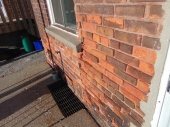I recently came across this video uploaded to Youtube from a user called David Mcfall, that shows him making large bricks from whole beer bottles and stabilized earth.
Now, I've got to say that I fell in love with the whole idea and I reaally like the fact that the beer bottles are whole and evenly spaced apart (satisfying, right?). I can imagine that fact saves time and energy since you don't need to cut the bottles like in other methods I've seen, plus the bricks probably lose a lot of weight due to the fact that the bottles are empty. I like the addition of the pine straw halfway through filling them with stabilized earth that I'm sure definitely helps with tensile strength. Lastly, I like the thickness and the length of the bricks which make me feel like the house will have good thermal mass. I hope these bricks aren't THAT heavy to move around.
After watching the video a few times I looked to see if there were any more detailed instructions but I wasn't able to find anything on the description or channel to my dismay. I was able to find a few things in the comment section though, he uses a 6:1 ratio of cob to cement and he mentions it took him about an hour of time per brick. As to the dimensions of the bricks, I just used some mathematical reasoning and Sketchup to make this image of what I think is the approximate size considering the spacing between bottles:

I wanted to document as much as I could on this video since I haven't seen it anywere else, but that leads me to my big question: what is your opinion on this technique? what do you think are the advantages / disadvantages of it? Also, what can you use as a mortar between these type of bricks to have good structural integrity? cement, mortar mix, adobe? Do you think one hour per brick is too high on the time scale? (I'm sure this can be optimized though) I've seen other bottle building projects and I'm just not very keen on using a mix with only sand plus cement since we live in an earthquake zone and that much cement in proportion would be quite expensive. I appreciate all of your input, thanks!









